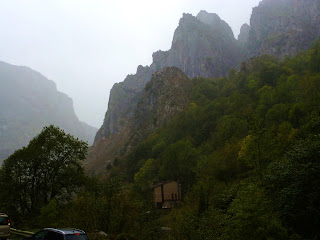Espagnette is a very spacious 12.6 m and a beamy 3.85 m wide. She has 3 bedrooms (so we have a storeroom), 2 bathrooms and a very big saloon. The boat is so wide it just fits inside the locks width wise.




Initially the river Baise was very narrow so we were running through a corridor of trees. It is very tranquil. Nothing happens quickly on a canal boat. In the narrow part we could only motor at 4 kph, now we are up to a heady 8 kph.


There's varying land use: maize, kiwifruit and apple cropping, poplar plantings, and some animal farming – geese and cows. While we are locking up or down, Choco aka the pirate, forages around the lock area and has supplemented the salads with wild walnuts and figs.
Plane trees and poplars have been the dominant species, and the treatment of the plane trees has been inventive at times as in these hand-holding specimens in Le Mas D’Agenais.
We’ve had some great overnight stays and done some good biking. Because we were in a river we had to stay in anchorages initially, rather than just tying up to the bank, but it’s made life very easy.
Night 2 Moncrabeau. The “head town of liars, boasters and storytellers of the kingdom.” The story goes that at the beginning of the 17th century several old soldiers who were enjoying their retirement, but running out of news to talk about. So they started to create their own news. A nearby monk in Condom approved of the concept and instituted the above name, and an academy of liars. A ‘best liar’ is still chosen on an annual basis, and as king/ queen of liars they sit on the chair of liars and adjudicate the following year to choose the best unlikely story.
Even better was the bike ride to a nearby chateau, Chateau le Carrejot, which makes Armagnac. It is a family affair. The grandfather and father manage the production on site. The son, who is studying the IB, gave us a tour and tasting. We started with a 1998 then a 1984 then a 1974, which was very smooth and finally a 1994 which had good ‘aromas’ as he termed it and mellow flavour. Heady stuff for middle of the day tasting. The distillation process was very interesting, involving lighting a fire under the brewed wine to vaporise the alcohol, which then transformed into the spirit and stored in barrels to age. Or at least I think that’s how it worked - the English wasn’t always clear. We settled on the 1994 Giacosa – Gold medal winner in Paris 2009. We’ve also taken on the technology so may develop a still.
Night 5 Le Mas d’Agenais. This village has many claims to fame. It is a walled city, and the 11-12 Century Romanesque church has a genuine Rembrandt of the living Christ on the cross. Thursday morning was market day, but my expectations exceeded the reality significantly. I guess it is late in the year.

Night 6 back to Buzet sur Baise
Night 7 Agen and time to return the boat. We stayed on the boat in the Locaboat base, did the laundry, had the last supper and emptied out the fridge and larder. I picked up our rental from Avis on Saturday am, dropped Choco and Vikki at la gare for their return to London by train. They have a couple of days there and then fly back to Melbourne
The weather’s been autumnal. We had some showers initially, then three days of beautifully warm weather after heavy morning mists burned off, and a cloudy but warm day today. The trees alongside the canal are losing their leaves slowly – lots of reflection shots.





















































